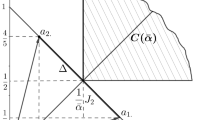Abstract
A class of two-person zero-sum games is introduced with Boolean strategies and a partially given payoff function, which is supplemented by methods of the theory of recognition of pictures. Logic descriptions are reconstructed for classes of strategies with equivalent values of the payoff function. It is proved that finding controlling strategies in the game is equivalent to the construction of simple implicants of logic descriptions of classes, which satisfy a simply verifiable condition. Cases of tranformation to a matrix game, and a dynamical procedure of supplementing of information in the game are described.
Similar content being viewed by others
References
N. N. Vorob'ev, Game Theory [in Russian], Leningrad Univ. Publisher, Leningrad (1974).
S.V. Yablonskii, An Introduction to Discrete Mathematics [in Russian], Nauka, Moscow (1979).
V. I. Donskoi, “Learning algorithms based on the construction of solving trees,” J. Comput. Math, and Math. Physics,22, No. 4, 963–974 (1982).
I. B. Gurevich and Yu. I. Zhuravlev, “Minimization of Boolean functions and effective recognition algorithms,” Cybernetics,3, 16–20 (1974).
Author information
Authors and Affiliations
Additional information
Translated from Dinamicheskie Sistemy, No. 7, pp. 140–146, 1988.
Rights and permissions
About this article
Cite this article
Donskoi, V.I. Dynamics of two-person zero-sum games with boolean strategies and partially given payoff function. J Math Sci 65, 1598–1601 (1993). https://doi.org/10.1007/BF01097671
Received:
Issue Date:
DOI: https://doi.org/10.1007/BF01097671




